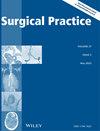Drain amylase values for clinically relevant post-operative pancreatic fistulae
Abstract
Aim
This study aims to identify the cut-off drain amylase (DA) values on the first, third, and fifth post-operative days (POD1-DA, POD3-DA, and POD5-DA) that are correlated with clinically relevant post-operative pancreatic fistula (CR-POPF).
Patients and Methods
All data were retrospectively collected from patients who underwent pancreatectomy at the Department of Surgery, Phramongkutklao Hospital, from January 2015 to December 2023. A total of 195 patients were included in the study.
Results
A total of 195 patients were analysed, including 35 patients with CR-POPF, with a mean age of 60.84 years. There were no statistically significant differences in demographic data between patients with CR-POPF and those without. In addition, no statistical differences were observed in pancreatic duct diameter (3 mm vs 2 mm), operative time (468.9 min vs 500.29 min), or blood loss (600 mL vs 600 mL) between the CR-POPF and no CR-POPF groups. Length of hospital stays was longer in the CR-POPF group compared with the no CR-POPF group (33 days vs 11 days, P = .001). In addition, the CR-POPF group had significantly higher rates of post-operative pancreatic haemorrhage (20% vs 2.5%), bile leakage (5.71% vs 0%), delayed gastric emptying (45.71% vs 3.13%), wound complications (34.29% vs 5%), and mortality (17.14% vs 1.88%) compared with the no CR-POPF group. The optimal cut-off values for CR-POPF were 1313 U/L on day 1 (D1; area under the curve [AUC] 0.72, 95% confidence interval [CI] 0.65–0.84, sensitivity 91%, specificity 52%), 492 U/L on D3 (AUC 0.77, 95% CI 0.70–0.83, sensitivity 91%, specificity 64%), and 360 U/L on D5 (AUC 0.65, 95% CI 0.52–0.75, sensitivity 69%, specificity 61%). There were no significant perioperative factors associated with CR-POPF in our study.
Conclusion
DA levels of 1313, 492, and 360 U/L on post-operative D1, D3, and D5, respectively, were associated with CR-POPF. Drain removal can be safely performed without the risk of CR-POPF when these levels are met.

 求助内容:
求助内容: 应助结果提醒方式:
应助结果提醒方式:


